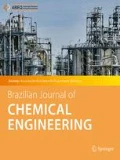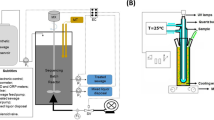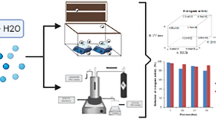Abstract
The presence of hormones in water represents a risk to the aquatic environment, especially due to the fact that these compounds are not effectively degraded by the traditional biological processes employed in wastewater treatment plant (WWTP). This work aimed to determine an optimum condition of the peroxidation process assisted by UV-C irradiation (λ = 254 nm) for the degradation of the hormone 17 α-ethinylestradiol (EE2) present in aqueous solution, in addition to the ecotoxicological evaluation. Synthetic EE2 samples (C0 = 1000 μg L−1) were treated using different processes: photolysis, peroxidation ([H2O2]0 = 25 mg L−1), and UV/H2O2 ([H2O2]0 = 25, 50, and 75 mg L−1). Photolysis and peroxidation in isolation were ineffective for degradation of the hormone in aqueous solutions, while the UV/H2O2 treatment provided total degradation of the compound, under the conditions employed. For real effluent samples from an WWTP, the UV/H2O2 process provided EE2 degradation efficiency of almost 100%, applying a photon flux of 2.76 kJ L−1 and with [H2O2]consumed = 42.5 mg L−1. The kinetic parameters for the UV/H2O2 treatment showed that the use of higher initial concentrations of peroxide resulted in slower degradation. Evaluation was made of the acute (considering immobility) and chronic (considering survival and reproduction) ecotoxicological effects of the treated effluent on the cladoceran Ceriodaphnia silvestrii. In the acute toxicity tests, an EC50 (48 h) value of 53.97% was obtained. The chronic toxicity tests revealed an adverse effect on reproduction, with an EC50 (8 days) value of 21.54%.



Similar content being viewed by others
References
Agência Nacional de Vigilância Sanitária (2017). ANVISA: Guide for validation of analytical and bioanalytical methods. Brazil
APHA, AWWA, WEF (2012) Standard Methods for examination of water and wastewater. American Public Health Association, Washington
Bertil M, Örnemark U (2014) The fitness for purpose of analytical methods: a laboratory guide to method validation and related topics. A laboratory guide to method validation and related topics. LGC, Teddington
Brazilian Association of Technical Standards (2016) NBR 12713: acute toxicity-test method with Daphnia spp (Crustacea, Cladocera). Brazilian Association of Technical Standards, Rio de Janeiro
Brazilian Association of Technical Standards (2017) NBR 13373: aquatic ecotoxicology-chronic toxicity-test method with Ceriodaphnia spp (Crustacea, Cladocera). Brazilian Association of Technical Standards, Rio de Janeiro
Britto JM, Rangel MC (2008) Advanced oxidation processes of phenolic compounds in industrial effluents. Quim Nova 31(1):114–122
Cédat B, De Brauer C, Métivier H, Dumont N, Tutundjan R (2016) Are UV photolysis and UV/H2O2 process efficient to treat estrogens in waters? Chemical and biological assessment at pilot scale. Water Res 100:357–366
Chow C, Leung KS (2019) Removing acesulfame with the peroxone process : transformation products, pathways and toxicity. Chemosphere 221:647–655
Costa CR, Olivi P, Botta CMR, Espindola ELG (2008) Toxicity in aquatic environments: discussion and evaluation methods. Quim Nova 31(7):1820–1830
Covinich LG, Bengoechea DI, Fenoglio RJ, Areal MC (2014) Advanced oxidation processes for wastewater treatment in the pulp and paper industry: a review. Am J Environ Eng 4:56–70
Deng Y, Zhao R (2015) Advanced oxidation processes (AOPs) in wastewater treatment. Curr Pollut Rep 1(3):167–176
European Commission (2018) Commission Implementing Decision (EU) 2018/840 of 5 June 2018 establishing a watch list of substances for union-wide Monitoring In The Field Of Water Policy Pursuant to Directive 2008/105/EC of the European Parliament and of the Council and Repealing Commission Implementing Decision 2015/495
Fagnani E, Guadagnini A, Silva GA, Guimarães JR (2013) Degradation of caffeine and methylene blue by advanced oxidative processes (POA). HOLOS Environ 13(1):85–97
Frontistis Z, Kouramanos M, Moraitis S, Chatzisymeon E, Hapeshi E, Fatta-Kassinos D, Mantzavinos D (2015) UV and simulated solar photodegradation of 17α-ethynylestradiol in secondary-treated wastewater by hydrogen peroxide or iron addition. Catal Today 252:84–92
García-Santiago X, Franco-Uría A, Omil F, Leman JM (2016) Risk assessment of persistent pharmaceuticals in biosolids: dealing with uncertainty. J Hazard Mater 302:72–81
Giroletti CL, Menezes JCSS, Oliveira TP, Dalari BLSK, Nagel-Hassemer ME (2019) UV/H2O2 process applied as post-treatment to remove solids in wastewater from the pulp and paper industry In: XXXI Brazilian Congress of Sanitary and Environmental Engineering, Natal
Grzybowski W, Szydlowski J (2017) The impact of chromophoric dissolved organic matter on the photodegradation of 17α-ethinylestradiol (EE2) in natural waters. Chemosphere 111:13–17
Hassemer MEN, Coral LA, Lapolli FR (2012) UV/H2O2 process as post-treatment for color removal and final polishing in textile effluents. Quim Nova 35(5):900–904
Instituto Nacional de Metrologia, Qualidade e Tecnologia (2003). INMETRO: Guidance on validation of analytical methods. DOQ-CGCRE-008. Brazil
Jorgensen SE, Halling-SØrensen B (2000) Drugs in the environment. Chemosphere 40(7):691–699
Liu Y, Sun H, Zhang L, Feng L (2017) Photodegradation behaviors of 17β-estradiol in different water matrixes. Process Saf Environ Prot 112:335–341
Mafra RC, Silva MP (2017) Application of photolysis and UV/H2O2 processes for degradation of the drug levothyroxine sodium in aqueous medium. In: IX Brazilian Symposium on Environmental Engineering, Belo Horizonte
Marmitt S, Pirotta LV, Stulp S (2010) Application of direct and UV/H2O2 photolysis to synthetic effluent containing different food dyes. Quim Nova 33(2):384–388
Martinez MS, Queiroz SCN, Pirez J (2015) Photo oxidative degradation of 17 β-estradiol present in synthetic effluent from the veterinary hormonal medication industry by UV/H2O2 process. Rev Eletrôn De Engenh Civil 10(2):01–10
Mazellier P, Méité L, De Laat J (2008) Photodegradation of the steroid hormones 17β-estradiol (E2) and 17α-ethinylestradiol (EE2) in dilute aqueous 68 solution. Chemosphere 73(8):1216–1223
Mohammed S, Fasnabi PA (2016) Removal of dicofol from wastewater using advanced oxidation process. Proced Technol 24:645–653
Moreira RA, Mansano AS, Silva LC, Rocha O (2014) A comparative study of the acute toxicity of the herbicide atrazine to cladocerans Daphnia magna, Ceriodaphnia silvestrii and Macrothrix flabelligera. Acta Limnol Bras 26(1):1–8
Moreira RA, Rocha O, Pinto TJS et al (2020) Life-history traits response to effects of fish predation (Kairomones), fipronil and 2,4-D on neotropical Cladoceran Ceriodaphnia silvestrii. Arch Environ Contam Toxicol 79:298–309. https://doi.org/10.1007/s00244-020-00754-7
Nicole I, De Laat J, Dore M, Duguet JP, Bonnel C (1990) Use of UV radiation in water treatment: Measurements of photonic flux by hydrogen peroxide actinometry. Water Res 24:157–168
Nogueira RFP, Oliveira MC, Paterlini WC (2005) Simple and fast spectrophotometric determination of H2O2 in photo-Fenton reactions using metavanadate. Talanta 66:86–91
Oliveira LLD, Nunes B, Antunes SC et al (2018) Acute and chronic effects of three pharmaceutical drugs on the tropical freshwater Cladoceran Ceriodaphnia silvestrii. Water Air Soil Pollutant 229:1–18. https://doi.org/10.1007/s11270-018-3765-6
Peroni T (2019) Advanced oxidative processes in the degradation of female sex hormones: kinetics, products and toxicity. Dissertation (Master in Environmental Engineering) Federal Technological University of Paraná, Francisco Beltrão
Ribani M, Bottoli CBG, Collins CH, Jardim ICSF, Melo LFC (2004) Validation in chromatographic and electrophoretic methods. Quim Nova 27(5):771–780
Rosenfeldt EJ, Chen PJ, Kullman S, Linden KG (2007) Destruction of estrogenic activity in water using UV advanced oxidation. Sci Total Environ 377(1):105–113
Sanson AL (2012) Methodology for Simultaneous Determination of Organic Microcontaminants in Surface Water by GC-MS and Chemometrics. Dissertation (Master in Environmental Engineering) Federal University of Ouro Preto, Ouro Preto
Santos MAPF, Melão MGG, Lombardi AT (2008) The effects of humic substances on copper toxicity to Ceriodaphnia silvestrii Daday (Crustacea, Cladocera). Ecotoxicology 17:449–454. https://doi.org/10.1007/s10646-008-0196-y
Sarkar S, Ali S, Rehmann L, Nakhla G, Ray MB (2014) Degradation of estrone in water and wastewater by various advanced oxidation processes. J Hazard Mater 278:16–24
Silva LLS, Sales JCS, Campos JC, Bila DM, Fonseca FV (2016) Advanced oxidative processes and membrane separation for micropollutant removal from biotreated domestic wastewater. Environ Sci Pollut Res Int 24:6329–6338
Souza FGC (2009) Removal of endocrine disruptors by heterogeneous photocatalysis and ozonation. Thesis (PhD in Engineering) São Carlos School of Engineering, University of São Paulo, São Carlos
Souza BM, Cerqueira AC, Dezotti M (2012) Evaluation of advanced oxidative processes combined with granulated activated carbon with biofilm for reuse of oil refinery effluents. Petro Quím 314:34–38
Souza RC, Silva TL, Santos AZ, Tavares CRG (2019) Treatment of hospital laundry effluents by advanced oxidative process: UV/H2O2. Eng Sanit Ambient 24(3):601–611
StatSoft Inc. (2004) Statistica: data analysis software system, version 7. StatSoft, Tulsa. http://www.statsoft.com/. Accessed 15 Jan 2020
Subtil EL, Mierzwa JC, Hespanhol I (2009) Performance evaluation of the UV/H2O2 system in the treatment of effluents from the heat treatment process of water and oil emulsions. Ambi-Agua 4(3):169–180
Vieira KM (2011) Application of oxidative, reductive and (photo) electrochemical processes in the degradation of drugs in aqueous media. Thesis (PhD in Sciences-Chemistry) Federal University of Minas Gerais, Belo Horizonte
Wang M, Li J, Shi H, Miao D, Yang Y, Qian L, Gao S (2018) Photolysis of atorvastatin in aquatic environment: influencing factors, products, and pathways. Chemosphere 212:467–475
Wee SY, Aris AZ (2017) Endocrine disrupting compounds in drinking water supply system and human health risk implication. Environ Int 106:207–266
Zotesso J, Cossich ES, Janeiro V, Tavares CRG (2016) Treatment of hospital laundry wastewater by UV/H2O2 process. Environ Sci Pollut Res Int 24(7):6278–6287
Author information
Authors and Affiliations
Corresponding author
Ethics declarations
Conflict of interest
On behalf of all authors, the corresponding author states that there is no conflict of interest.
Additional information
Publisher's Note
Springer Nature remains neutral with regard to jurisdictional claims in published maps and institutional affiliations.
Rights and permissions
About this article
Cite this article
Silveira, L.F., Santos, J.L.F., Prado, F.L.C. et al. Application and ecotoxicological evaluation of UV-assisted peroxidation for degradation of 17α-ethinylestradiol in aqueous media. Braz. J. Chem. Eng. 39, 67–76 (2022). https://doi.org/10.1007/s43153-021-00122-5
Received:
Revised:
Accepted:
Published:
Issue Date:
DOI: https://doi.org/10.1007/s43153-021-00122-5




